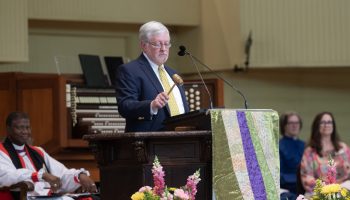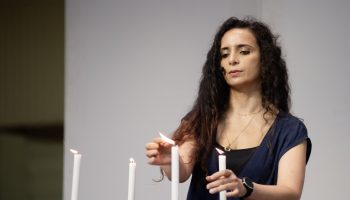
Cody Englander
Staff Writer
There are 90 kilometers separating Iran from the Gulf States — 90 kilometers that have influenced trillions of dollars and America’s involvement in the region.
At 10:45 a.m. Tuesday in the Amphitheater, Vali R. Nasr took to the stage, where he discussed U.S. involvement within the Gulf States for the Chautauqua Lecture Series Week Eight theme, “The Middle East: The Gulf States’ Emerging Influence.
Nasr is a political commentator and writer of Iran’s Grand Strategy: A Political History; The Dispensable Nation: American Foreign Policy in Retreat; The Shia Revival: How Conflicts within Islam Will Shape the Future; and co-author of Democracy in Iran and How Sanctions Work: Iran and the Impact of Economic Warfare.
The lecture began with Nasr clarifying the importance of the region, and the deep financial stakes held by countries across the globe. Kuwait, Saudi Arabia, Qatar, Bahrain, United Arab Emirates and Oman are the countries that make up what are known as the Gulf States. To Nasr, some of their importance comes from their proximity to the Red Sea.
“As a sort of a hub in a world trade where the spokes go in different directions, they happen to be in the Middle East, but the Gulf States don’t want to be seen as the Middle East per se,” Nasr said.
Nasr largely focused on Qatar, Saudi Arabia and the UAE. These countries bring in trillions of dollars to fund financial institutions in the West and East, as well as “carrying weight” with President Donald Trump. Other Americans find these three countries “attractive” because of their success story.
“We would like to think that that is the future of the Middle East,” Nasr said. “We would like to think that somehow, these three countries represent something much bigger.”
Despite this, Qatar, Saudi Arabia and the UAE have low populations compared to the rest of the Middle East. These three countries don’t define the region, according to Nasr, and sometimes get confused as the Middle East by the media and White House.
“It is a very good story in its own terms, but it is not the Middle East,” Nasr said.
These countries are still susceptible to conflict in the region and can have difficulty drawing in American or European citizens. The Gulf States are reflexive of the conflicts around them.
“It is highly vulnerable to what happens in Israel, what happens with Turkey and what happens to Iran,” Nasr said. “It is highly vulnerable to what happens to the other 250 million Arabs living around them. I mean if Egypt sneezes, Saudi Arabia will catch a cold — that is what the fear was during the Arab Spring. There is no such thing as the Gulf being immune to the rest of the Middle East. In an imaginary way, you may think of it, but you can’t. Geography matters.”
According to Nasr, the largest regional conflict is between the United States and Iran, a country 90 kilometers from the Gulf States.
Nasr explained the historical impact of the Gulf States, which began to experience expansive financial growth in the 1920s when the worldwide quest for oil expanded to the area. The United States soon became a major player in the region, and Nasr credited them for the existence of Saudi Arabia.
“Saudi Arabia is actually the oldest American relationship in the Middle East,” Nasr said. “It predates America’s relationship with Israel by about at least a decade or more than a decade.”
Beginning in the 1920s, the United States became involved to curb the influence of Soviet Russia, and later, the Soviet Union.
“That is why the United States determined and resolved to force the Soviets out of Afghanistan,” Nasr said. “Now, we in the United States did not always sign up to defend the Gulf on our own.”
With a post-colonial vacuum created as countries declared independence from Britain, the United States looked to rely on Iran to police the area.
“Mind you, the Arabs were not happy with an American/Iranian condominium basically being the big daddy protecting (the Gulf States), but they did not have a choice,” Nasr said. “The fall in 1979 has had many, many consequences. We have thought about the rise of Islamic activism and Americanism and the hostage crisis, one of the most significant issues was that it broke down that security arrangement immediately overnight.”
The Iran hostage crisis was a turning point, according to Nasr, when the country went from being a protector of the Gulf to becoming a threat to the region.
After the 1979 attack on the American embassy in Islamabad, Pakistan, the United States has become more involved in the region.
“So, a close alliance between America and the Arab states of the Gulf, those are the states containing the Iranian threat,” Nasr said.
During the Iran-Iraq war of the ’80s, America took direct involvement by bombing Iranian oil rigs. This cemented its regional involvement for years to come.
“There is no other region in the world where the United States has this degree of investment on the ground,” Nasr said.
America’s actions in the region increased post-
9/11, with the hope to “surgically” resolve the gulf security conflict.
“Why go to Iraq at that time? Because the American people were angry, they were not going to ask too many questions about the war,” Nasr said. “They could subscribe to a kind of radical surgery that they may not have done otherwise.”
According to Nasr, there was a theory surrounding the collapse of Iran. The country would fall if Saddam Hussein could be taken down, or if Iraq was turned to a “Switzerland in the Middle East,” the Iranian population would topple their own regime.
“We got rid of Saddam. That was the easy part,” Nasr said. “But, kind of like a cartoon, you damage everything, and you are standing there, and you say, ‘Now what?’ You cannot build a shining city on the hill — we still cannot. Iraq is away from that war and still limping along.”
The U.S. involvement soured its relationship with many countries in the Middle East, which had seen America step into their region and take control. The question then arose within the region — why not go to China for help?
Nasr described the mindset of the Gulf countries relative to Chinese aid.
“(They think) we have to pivot to Asia, which basically means, ‘Let’s get out of the Middle East,’ ” Nasr said. “… These rich Arab countries became extremely alarmed because they can’t defend themselves.”
Since the Carter Doctrine, the Gulf States were protected by the United States under former President Barack Obama — that looked to change. While war wasn’t imminent, eyes were on Iran’s nuclear program. Obama wanted to strike a deal with Iran and leave the region. According to Nasr, surrounding countries were worried Iran would be “let out of the cage” America had placed them in.
During the first Trump administration, the U.S. presence in the country was more reactionary.
“President Trump only took that decision after the American Embassy was threatened and after an American had been killed, not because of an attack on Saudi Arabia or UAE, per se,” Nasr said.
After a missile strike on a U.S. base in Iraq, which saw no casualties, Trump didn’t pursue further conflict. America at this point wasn’t interested in the offensive side of containing Iran. The region looked to other options for protection.
“What about China? What about Russia? Yes, they are not going to send aircraft carriers to the Gulf, but they have a lot more influence,” Nasr said. “If you have a problem with Iran, maybe calling the White House is not the best thing, but you can call Beijing or you can call Moscow.”
China has established relationships in the region, notably between the UAE and Saudi Arabia. Tensions between the countries have simmered down.
“Today, Saudi Arabia is China’s largest oil supplier, and China is Saudi Arabia’s largest oil consumer,” Nasr said — which means that the United States is no longer the only player in the region.
Trump has made his own kind of plays to compete.
“Saudi Arabia, Qatar and UAE are his kind of countries. All the gold and glitz and over-the-top reception — one of them offers him a jumbo jet for a private plane, the other $1.4 trillion of investment to the U.S., the other $1 billion,” Nasr said. “They basically made him realize there is a lot of money to be made here.”
Again, the issue stems from the 90 kilometers from the Gulf to Iran.
“How wise is it to invest in the backbone of American artificial intelligence and chip making, 90 kilometers from Iran? You are creating another Taiwan problem,” Nasr said.
He still doesn’t believe the Gulf States have a “100% trust” in Trump or the United States for protection. If conflict begins, the Gulf States will feel it.
“When missiles start flying, United Arab Emirates airlines stop flying,” Nasr said.
The financial risk is realized by Iran, China, the United States and the Gulf States.
“Today there is calm,
but maybe not tomorrow,” Nasr said.




